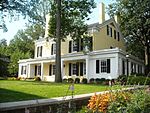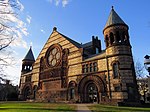Nassau Hall

Nassau Hall, colloquially known as Old Nassau, is the oldest building at Princeton University in Princeton, Mercer County, New Jersey, United States. In 1783 it served as the United States Capitol building for four months. At the time it was built in 1756, Nassau Hall was the largest building in colonial New Jersey and the largest academic building in the American colonies.The university, originally known as the College of New Jersey, held classes for one year in Elizabeth and nine years in Newark before the hall was completed in 1756. Designed originally by Robert Smith, the building was subsequently remodeled by notable American architects Benjamin Latrobe, after the 1802 fire, and John Notman, after the 1855 fire. In the early years of Princeton University, Nassau Hall accommodated classrooms, a library, a chapel, and residential space for students and faculty. It housed the university's first Department of Psychology. During the American Revolutionary War, Nassau Hall was possessed by both British and American forces and suffered considerable damage, especially during the Battle of Princeton on January 3, 1777. From June 30 to November 4, 1783, Princeton was the provisional capital of the United States, and Nassau Hall served as its seat of government. The Congress of the Confederation met in the building's library on the second floor. According to Princeton University, "Here Congress congratulated George Washington on his successful termination of the war, received the news of the signing of the definitive treaty of peace with Great Britain, and welcomed the first foreign minister—from the Netherlands—accredited to the United States."At present, Nassau Hall houses Princeton University's administrative offices, including that of the university's president. Old Nassau refers affectionately to the building and serves as a metonym for the university as a whole. The U.S. Department of the Interior designated Nassau Hall a National Historic Landmark in 1960, "signifying its importance in the Revolutionary War and in the history of the United States."
Excerpt from the Wikipedia article Nassau Hall (License: CC BY-SA 3.0, Authors, Images).Nassau Hall
Elm Drive,
Geographical coordinates (GPS) Address Nearby Places Show on map
Geographical coordinates (GPS)
| Latitude | Longitude |
|---|---|
| N 40.348738888889 ° | E -74.65935 ° |
Address
Elm Drive
08542
New Jersey, United States
Open on Google Maps











